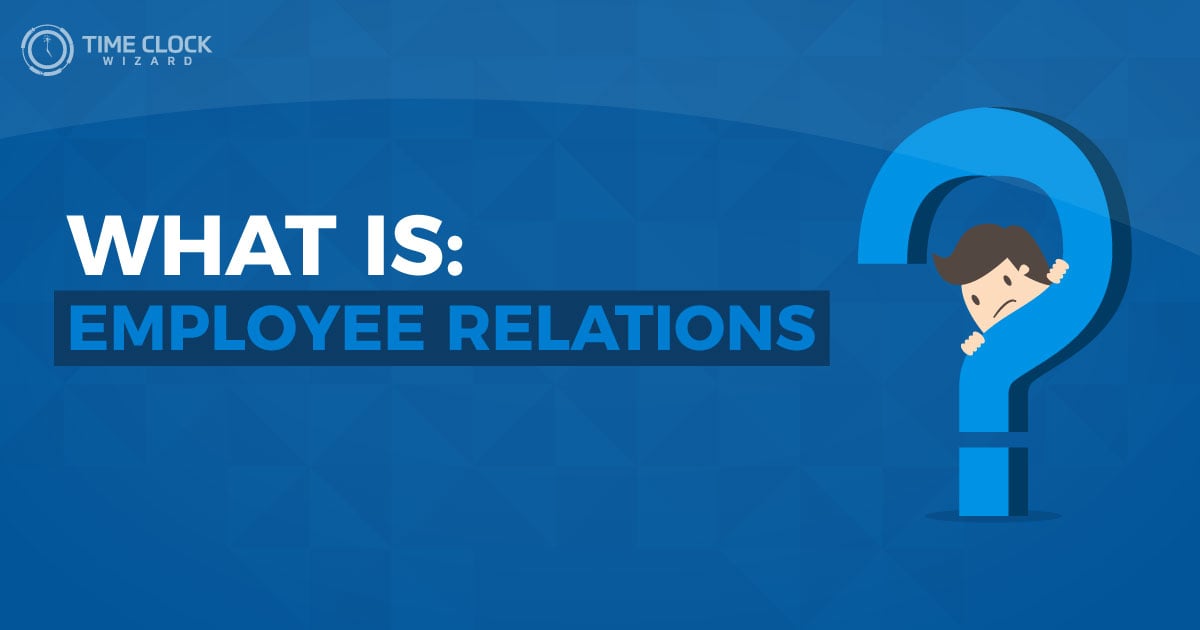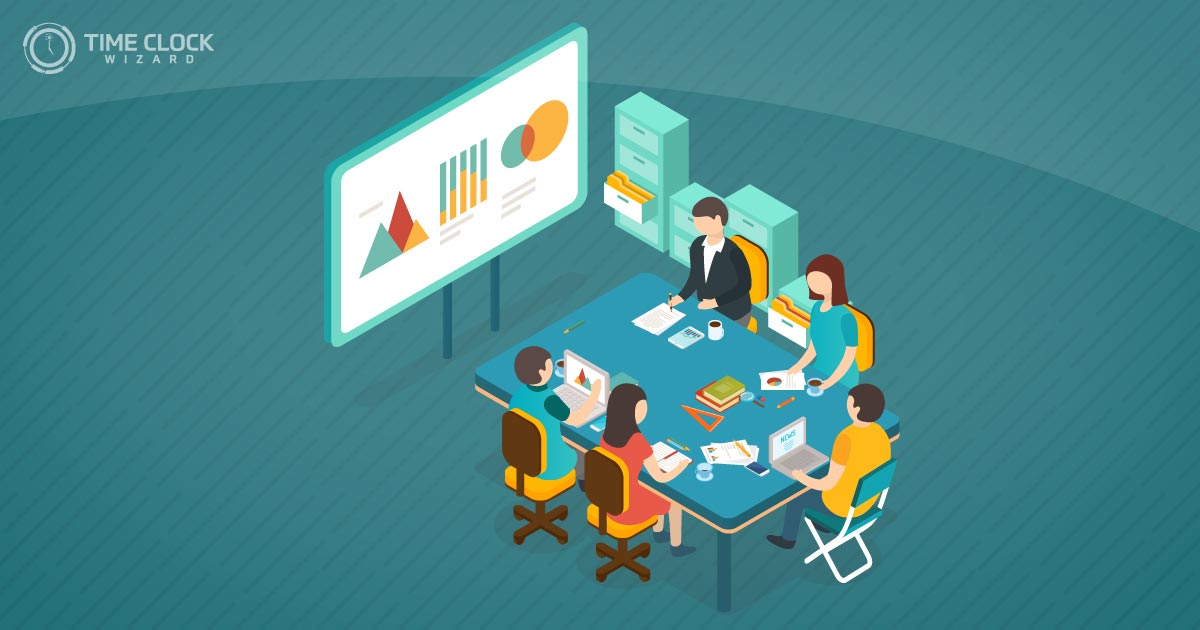
Success in today’s globalized market requires more than just having a great product to sell. It requires people working together in a way that brings out the best in all of them. Individual talent just isn’t enough. These days, companies have to be more than the sum of the parts. They need something to emerge that isn’t present in any single employee. As managers, you already know you need cohesion, synergy, and the ability to adapt on the fly. But before any of this can happen, you’ll have to develop strong employee relations.
Every team is a mix of very different personalities. This certainly isn’t a bad thing– diversity produces the best ideas– but it takes a certain finesse to bring different personalities together. That’s why we’ve created this practical guide to developing positive employee relations. In the ensuing sections, we’ll discuss the most important aspects of these relations:
- The essentials of employee relations
- The most common employee relations problems
- The employee life cycle
- Managing the employee life cycle
- Building strong employee relations
What is Employee Relations?
The meaning of the term ’employee relations’ might seem obvious at first glance, but it’s actually more complex than you might think. Remember– facilitating positive employee relations means dealing with human beings. And like we said above, the people who work with have a nearly endless array of different personalities. Add in the challenges your organization will face in the coming years and it’s easy to see how complicated employee relations can become.
Let’s begin with a working definition. Broadly speaking, the term employee relations refers to the multifaceted relationships that exist between a business and its employees. This probably sounds pretty obvious, but a closer look will reveal the often tangled complexities that contribute to the employer/employee dynamic.
A Multifaceted Concept
Employee relations involve many different factors. These factors include the legal, psychological, and practical relationships that employees have with their employers. These different relationships are both distinct and overlapping at the same time.
And while you could write an entire book about each of them, there’s one thing that they all have in common. These relationships can go one of two ways. In short, they’ll either improve your company’s prospects or damage them.
Positive employee relations are grounded in things like trust, appreciation, and mutual respect. They’re also marked by open communication, responsiveness, and transparency. Employee relations that damage your chances are pretty much the exact opposite. In other words, they’re marked by confusion, fear, and indifferent treatment. You should also be on the lookout for things like secrecy, unequal treatment, and a lack of personal regard.
Measure your employee relations in these generalized terms and you’ll get an idea of how things stand pretty quickly. If your company is like most, your employee relations will be somewhere in between these two extremes. But no matter how good (or bad) your employee relations are, there’s always room for improvement. To make these improvements, you’ll need to dig a little deeper into the nature of employee relations.
The Basics of Employee Relations
As you’ve probably already noticed, there’s a lot going on in the employer/employee relationship. It’s almost too much to take in, especially if you’ve worked with the same team for very long. When this happens, the relationships that define your workplace can turn into background noise. But while this is certainly understandable, it’s in your best interest to step back for a moment to see how things stand.
You have to keep constant tabs on the state of your employee relations. The best way to start is by focusing on their most fundamental parts. Here are five things you should consider when making your assessment:
1. The amount of effort a company makes to build positive relations:
A little effort goes a long way toward building strong employee relations. Ask yourself: what exactly does my company do to strengthen our employee relations? If the list is short or you can’t even answer right away, then you know you’re not doing enough.
2. How often the employer recognizes milestones and accomplishments:
People want to be acknowledged for the hard work and training they’ve done. This holds true at home and in the workplace both. It’s simply a part of human nature. The ways that employee recognition programs can motivate people is already well-established. So if you have programs in place already, you’re off to a good start. But a word of praise or the occasional little perk couldn’t either. Done properly, this forms of validation can work wonders for your employee relations. Just remember that it’s important to spread the encouragement around.
3. The openness of company communication:
You’ve heard it again and again, but communication is the key to any workplace relationship. And the role it plays in employee relations is definitely not an exception. Your staff needs to know what they’re supposed to be working on all times. They also need to know how they’re progressing. You can accomplish these only by maintaining open lines of communication. Whether it’s face-to-face contact or during a virtual session, your team needs to know that you’re consistently available to discuss concerns or questions with you.
4. Equality of opportunities:
Do the same people get chosen again and again to attend conferences, seminars, and other outside work events? When appropriate, do your people all have equal access to advanced educational and training sessions? When considering promotions, does your company cast a wide net, or do they draw from a smaller pool? Answer these questions and you’ll gain a great deal of insight into the level of equality in your company. It’s also a great idea to ask for employee feedback on this topic.
5. The amount of feedback your employees typically receive:
A constant flow of managerial feedback is crucial an individual’s development and the strength of your overall employee relations. This is true whether the feedback you need to give is positive or negative. Without positive feedback for a job well done, an employee will feel unappreciated and their productivity will suffer.
A different sort of problem arises when management is open about an employee’s poor performance. If you’re not clear and open when an employee’s performance isn’t up to par, they have no way of recognizing their problem areas. This is another area where equality comes into play. You should distribute your feedback– good or bad– between all your employees equally. Regularly scheduled performance evaluations are a great way to make sure this happens.
Common Employee Relations Problems
Hopefully, you’re starting to get an idea of the complexities involved in employee relations. In this section, we’ll touch on some of the most commonly encountered problems in the area of employee relations. The purpose of this is twofold. First, you’ll be able to use these problems as ‘case studies,’ and see how they might apply in your office right now. Second, examining the most common problem areas will help you formulate a strategy for solving them.
Disagreement Over Wages and Time worked
If you’re like most HR managers, you encounter a lot of employee problems right after payday. This is when employees want to haggle over the hours they’ve worked, argue about mileage reimbursements, and claim overtime hours you’re not sure ever happened.
Two things can help prevent these types of disputes. First, you’ll need to know how to avoid violating federal wage and hour regulations. This includes, but isn’t limited to, The FLSA overtime rule. Gain a thorough knowledge of these regulations and you’ll eliminate headaches in advance.
Second, take advantage of the time tracking software that’s out there. Examples of this include things like a work schedule app, a timesheet app, and a salary paycheck calculator. These all represent affordable ways to make sure all the numbers line up.
Conflict Resolution
Workplace conflicts are a part of doing business. They can arise at any time and for a variety of reasons. In other words, you should expect them to happen on an almost daily basis. The key is how you manage these conflicts and bring them to a resolution.
This is where conduct and procedural policies come into play. Make sure you formulate these policies clearly and that everyone understands what they entail. You won’t be able to anticipate every conflict that’s going to arise, but having a resolution process in place will cover the lion’s share.
Salary Increases
You can probably count your employees who are satisfied with their pay rate on one hand. Everyone wants to make as much money as they can, and frustrations can boil over if you don’t have a standard procedure for salary increases in place. Having this procedure in place lets everyone the criteria for pay raises and gives you an ideal assessment tool as well.
Disputes Over Company Leave Time
Disputes over company leave time are very common. Usually, they arise from one out of two sources. The first is when employees don’t understand your leave policies. The solution here is pretty straightforward. Make sure your leave policies are posted where everyone can see them and inform staff whenever anything changes. It also helps if employees know you’re available to answer any questions they might have.
The second type of leave dispute happens when your policies aren’t in complete accordance with state and federal regulations. To prevent this, use leave management software to create leave policies that are legal, accessible, and transparent.
This is obviously an incomplete list of the problems you’ll encounter while managing employee relations. But it will still give you a good idea of what to expect and let you develop the tools you need to solve a wider array of these problems.
What is the Employee Life Cycle
A deep understanding of your people’s work experience is central to maintaining positive employee relations. And while you might trust your intuitions on the subject, more is usually required. One great way to dig into what it’s like to work for your organization is taking a long look at something called the ’employee life cycle.’ In the following sections, we’ll take an in-depth look at this fascinating concept.
The term ‘employee life cycle’ refers to a model that human resources departments use to trace the development of an employee within their company. It describes both the individual growth of an employee and the ways in which HR can facilitate it. In essence, the employee life cycle is a rich description of how their team members develop throughout the course of their career.
The phrase ‘life cycle’ is very appropriate here. This is because the stages used to describe an employee’s job experience are similar to the terms you see used in biology. You can think of the employee life cycle model in the following way:
- A given staff member is like an organism that lives in a certain environment.
- The workplace and its culture make up the environment in which the employee develops.
- The employee develops within the context of the workplace, not on their own.
- The staff member and the employer share the responsibility of creating a positive experience.
- Employees develop best when a positive company culture is already in place.
Personalization is Key
These five statements make for a good introduction to the concept of an employee life cycle, but it’s definitely incomplete. We also need to add an important disclaimer. Describing the employee as an organism is not an attempt to dehumanize them in any way. In fact, the intent here is quite the opposite.
The model we described above is just that– a model. It’s a tool used for understanding– and eventually improving– the experience an employee has while working for your company. And the ‘organism model’ is simply a way of expressing how employee relations develop within your workplace’s ‘ecosystem.’
HR departments and management teams play a huge role in the employee life cycle. A big part of this role is personalizing their staff’s work experience. And understanding the connections between employees and their work environment is an ideal way to begin this humanizing process. Next, we’ll look at the various stages of the employee life cycle.
The Six Stages of The Employee Life Cycle
There are many aspects to managing the employee life cycle effectively. First, you’ll need to understand how it progresses over time– its various stages. Second, an employee’s needs and expectations evolve over the course of their time with your company. The same holds true of your company itself. For example, management teams expect a new hire to be receptive and eager to learn during the early days of their employment, while a more assertive attitude might be necessary as their career develops.
Lastly, the employee life cycle isn’t something that just happens on its own, or at least not in a way that achieves desired outcomes. The life cycle of your employees is something that can be managed. In fact, it has to be managed to optimize individual performance and company success. This necessitates the use of certain management techniques, ones that are modulated to fit the employee life cycle’s progressive stages.
We’ll elaborate on all this in the following sections. To start, let’s take a deep dive into the stages of the employee life cycle. Depending on who you talk to, the employee life cycle is divided into anywhere from four to seven stages. The division we’ll use here consists of the following six:
1. The Employee Attraction Stage
This is the period of time when your company tries to attract the right employees to come work for it. The attraction stage is an ongoing process and actually begins before a given position opens up. Intimately related to your ‘employer brand,’ the attraction stage is when your company develops its reputation. More pointedly, it’s when potential employees begin to form perceptions about your company, especially if it’s considered a ‘good’ or ‘bad’ place to work.
Your company makes constant efforts to manage the perceptions of your current and possible customers. Similarly, it needs to brand itself in a way that’s appealing to active and potential employees. The branding process requires evolving and active effort. Understanding this lets you adopt the proper attitude toward employee attraction.
It doesn’t matter how strong your products and services are if you don’t attract great people to your company. But competition for the talent you need is incredibly fierce, especially in today’s global market. So you’ll need to do everything you can to create a positive reputation for your company. And this applies as much to your potential employees as it does your customers.
2. The Recruitment Stage
The recruitment stage is pretty much what the name implies. It’s the period of time when you actively seek out topnotch employees to work for your organization. Typically, a given recruitment stage begins when your company needs to fill a vacant role or creates a new position. The need for recruitment is usually– though not always– the most intense during times of company expansion.
The recruitment stage includes a number of related processes. Talent acquisition is one of the most important parts of the recruitment stage. A wide-ranging term, some parts of the talent acquisition process go beyond the recruitment stage. But for our purposes, it includes things like employee tracking and interviewing candidates.
Referrals from your existing team often play a huge role in the recruitment stage. Because your team members work in the industry sector you’re hiring for, they’re likely to know great potential candidates for a particular opening. Obviously, you’ll need to exercise caution when using referrals during the hiring process, but your current team members are often your best filters and advocates.
It should go without saying that your ability to recruit top talent has a lot to do with the attraction stage. You can bring in the top talent in the world, but it won’t do you much good if you have a poor employer reputation. That’s why it’s imperative to work on the attraction and recruitment stages simultaneously.
3. The Adjustment Or On-boarding Stage
Ideally, the results of the recruitment stage is a set of fabulous new hires. But hiring good talent is just the beginning. After that, you’ll need to help them bet on board and adjust to a different work environment. In other words, you’ll need to help them transition and reduce their ‘culture shock.’
This period is called the adjustment or on-boarding stage of the employee life cycle. It refers to the process of getting new hires acclimated to their new positions as smoothly as possible. Changing jobs is an exciting but challenging part of an employee’s life, but it’s not always an easy thing to do. As a result, you’ll need to have a plan in place to help them make this sometimes difficult transition.
On-boarding includes introducing people to the performance expectations involved in their new job. Additionally, it’s the period when new staffers learn the skills, attitudes, and behaviors that will help them work productively within your company. Lastly, the on-boarding stage of the employee life cycle is the time when you should go out of your way to make new employees feel welcome. People work best when they’re comfortable in their surroundings. Making your new hires feel welcome right from the start is the best way to help them get comfortable.
4. The Career Development Stage
The next step of the employee life cycle is known as the career development stage. This is when an employee begins to create the career path they’ll take while working for your company. But they can’t create this path on their own. They’ll need help from both HR personnel management to advance through ranks.
There are many different factors at work during the development stage. First, employers usually discuss potential team members’ career goals during the interview process. This gives both sides a fair idea of how a particular employee’s development is likely to proceed. This discussion also shows if the often divergent plans of the employee and the company are in alignment.
The development stage also includes the types of training employees receive, as well as the kind of projects they’re likely to work on. Lastly, certain intangible workplace elements factor into the career development stage. These include things like employee recognition, encouragement, and a sense of belonging.
The development stage is obviously important to both you and your team members. Today’s workers are more ambitious than ever. They’re eager for the training and opportunities they need to develop next level skills. People don’t stay at the same company as long as they used to, and if your employees will move on if they don’t feel they’re receiving what they need to grow in their field.
5. The Employee Recognition and Retention Stage
Next, team members enter into the employee recognition and retention stage. Often referred to simply as the retention stage, this is the period of time when the ‘fate’ of an employee starts to be decided. It is during the retention phase that both sides– the company and the employee– decide if they have a future together.
On the employer side, this is when management and HR should channel their energy into keeping good people in the fold. We’ll discuss strategies for employee retention a little later on, but the goal should always be to keep good employees happy, challenged, and satisfied.
Company culture plays a huge role in employee retention. Talented workers know they have many options, so they won’t stick around if morale is low or if they don’t feel appreciated. Employee recognition programs can have a very positive impact in this area. The desire to be acknowledged for a job well done is universal, and employees tend to stay with companies that offer such validation.
6. The Separation or Off-boarding Stage
The final stage in the employee life cycle is called the separation or off-boarding stage. At some point, an employee’s time with your company comes to an end. This can happen because of retirement, new opportunities, or for a variety of personal reasons. Of course, termination is another way that an employee’s time working for you can end. But whatever the reasons are, the off-boarding stage is just as important as the other stages in terms of maintaining a great reputation and a positive company culture.
An employee’s departure often affects other team members in profound ways. A pair of examples should suffice to illustrate this point. Imagine a scenario where an employee with twenty years’ experience decides to retire and HR puts little or no effort into celebrating their departure. Obviously, this would put doubt and uncertainty into the minds of your remaining employees. Similarly, you can expect to create deep suspicion or resentment if you terminate an employee without ample warnings and counseling.
As you can probably see, the main thing is to avoid unnecessary disruption when an employee leaves your company. Depending on who it is that leaves, there is bound to be a certain amount of upheaval when an employee ends their tenure with you. But a good off-boarding strategy can keep the disruption to a minimum and preserve order within the ranks.
Two Sides of the Same Coin: Employee Relations and the Employee Life Cycle
Hopefully, you’ve started to see the deep connection that exists between the employee life cycle and employee relations more generally. As we’ve already established, the term ’employee relations’ encompasses a broad spectrum of interactions between team members and the company as a whole. And although these interactions seem to play out simultaneously, their formation is actually organic.
Employee relations arise from a multilayered backdrop or context. Many workplace elements factor into this backdrop, but the way you manage the stages of the employee life cycle certainly play a major role. Companies that underemphasize or ignore this role do so at their peril. They typically experience a slow boil of low morale, inefficiency, and decreased productivity. And these problems become progressively more difficult to solve the longer this glaring neglect continues.
This leads us to an aspect of managing employee relations that is too often blurred or forgotten. Your staff isn’t a team of unfeeling robots. They’re human beings who lead rich lives in and out of the workplace. They’re people who are interested in achieving work-life balance. And it’s imperative that HR and management personnel help this process along.
Broadly speaking, there are two reasons this help is so important. First, HR and management personnel are human beings too. And most of them want to assist their employees in achieving a work-life balance for its own sake. Secondly, top companies understand that this is the best way to maximize productivity and their bottom line. Now that you understand this important connection, we can explore the best management techniques for each stage of the employee life cycle.
Best Management Practices Over the Course of the Employee Life Cycle
There’s just no doubt about it– managing people is the most difficult part of running a business. No matter how big (or how small) your company is, managing your staff is complex, challenging, and constantly changing. And while this might sound like bad news, understanding these difficulties is an essential part of your company’s long-term success.
Equipped with this understanding, you can discover the best ways to motivate, engage, and direct your team effectively. Of course, this is only the beginning. Understanding is nothing without constructive action. That’s why you’ll need to learn techniques to overcome the management challenges in each stage of the employee life cycle. We’ll explore these techniques in the next few sections.
Employee Attraction Strategies
Any effective attraction strategy must be well-planned, adaptable, and continuous. If this sounds a little like a marketing campaign, then you’re on the right track. As we said above, there is a great deal of overlap between the attraction stage and the process of company branding. But there’s one key difference– management techniques during the attractions stage focus on your staff, not your customers. With that in mind, here are three tips for effective management during the attraction stage:
1. Maintain a great company culture: With a positive company culture in place, your current team members are certain to spread the word about the great work experience they’re having. As a result, you’ll develop a good reputation within your industry sector and automatically attract great people.
2. Stay visible within your industry: This is an area where the marketing analogy is definitely fitting. When you’re marketing a given product or service, one of the keys to success is maintaining brand visibility. And the same holds true when managing the attraction stage. Stay near the epicenter of your industry by sending your managers to conferences, seminars etc, and you’ll stay on the right people’s radar as a rewarding place to work.
3. Offer employees a strong compensation and benefits package: Money isn’t everything, but you’ll least have to be competitive with similar companies to attract the best people. But it’s also important not to underestimate the importance of employee benefits in this regard. This can include things like flexible working hours, an attractive retirement fund, and a little extra vacation time. But you shouldn’t feel restricted to these conventional packages– a few extra perks can go a long way toward making your staff feel properly compensated.
Putting Your Best Foot Forward During the Recruitment Stage
We’ve already emphasized how employee referrals can strengthen your recruitment efforts, but there are other ways to accomplish this. Here are three ways to help you manage the recruiting stage:
1. Focus on potential hires who fit your company culture: Cultural fit is of paramount importance during the employee life cycle, but you have to start actively seeking it during the recruitment stage. This means something different for every company, but true culture fit requires a sharing of core values. Toward that end, make sure your company’s core values are posted somewhere on your website and discuss them with during every employee interview.
2. Be specific and purposeful during your search: During the recruitment stage, you’re looking for the right person for the right job, so carry out your search with precision and purpose. Set a tone for your recruitment practices right from the beginning, with ads and postings that specify the exact type of person you’re looking for, as well as the skill set they’ll need to obtain the position. By proceeding in this way, you might cast as wide a net, but you’ll save a great deal of time and strengthen your reputation.
3. Ask your existing team for help: Your current team can be invaluable during the recruitment stage. We’ve already mentioned employee referrals, but let them participate even further for best results. Ask them to help formulate the requirements for the position. Invite a staff member who plays a parallel role to look at resumes and join in on certain parts of the interview process. The benefits of this further inclusion should be fairly clear at this point. Among other things, your staff can provide an up-close view of the needs of the position and help decide if a given candidate is a good cultural fit.
Best Practices During the On-boarding Stage
No matter how promising their new position is, new hires work best if they have a smooth transition. Therefore, it’s in everyone’s best interest to make this transition as pain-free and as seamless as possible. Take these steps to make sure this happens:
1. Come up with a concise job description: New hires need to know what’s expected of them right from the start. Convey this information with a brief description of the duties and behaviors your company needs to see as they begin to fill their role. Not only will this help them settle in more quickly, but it will also give you an assessment tool for later on.
2. Discuss your company’s mission and values: Sit down with your new hire in the first few days and go over your company’s value system and overall mission. That way, they’ll have a clear idea of what drives your operating procedures and contribute to them appropriately. It will also give them a great tool for self-assessment.
3. Check in with new hires frequently: By now, the new hire should know exactly what’s expected of them. But that doesn’t mean they’ll be able to apply the knowledge consistently. This is especially true during the initial period of their tenure with your company. Follow up with them frequently during this period to cement this new knowledge and address any concerns.
Helping Your Staff Along: Managing the Development Stage
The development stage is the most significant part of the employee life cycle because it can benefit them for the rest of their work life. This holds true no matter how long they work for your company, so proper management of this stage will make your company much much more attractive to potential hires. Here are some tips for managing the development stage:
1. Encourage your team members to pursue outside training opportunities: By providing your staff with the chance to participate in industry seminars and conferences, you accomplish two things at once. First, the employee will return with an enriched skill set that will make them more valuable to you. Second, you’ll provide them with new challenges and the means for advancing their career.
2. Recognize employees for learning during their personal time: It’s important for management to recognize efforts their employees make to improve their skills outside the workplace. Many people do this on their own, but it helps if you encourage these efforts as well. Either way, you should validate their efforts with private and/or public recognition. Additionally, you should consider giving them assignments that allow them to utilize this new knowledge.
3. Make employee development a shared enterprise: People develop best as part of a group, so management should participate in their career development as much as possible. Praise and encourage are always great motivators, but active participation is even better. Team up with your employees to discover the areas in which they excel, as well as where they could use some improvement. Then, use this knowledge to plan their future development. Lastly, arrange for an experienced manager to act as a mentor for interested employees. This will go a long way toward establishing trust and deepening your employees’ commitment to your organization.
Keeping Your People: Strategies for Employee Retention
Hiring good people is only the beginning. You also have to keep them happy enough to retain them over the long term. It’s the best way to maximize productivity, keep up morale, and avoid the obstacles that high turnover can cause. Entire books have been written on the value of employee retention, but here are three ways you can best manage this important stage:
1. Find and hire the right people: Never overlook the importance of hiring people who fit your organizational vision. This is where a thorough screening process comes into play. Discuss a potential new hire’s goals and value systems right up front to achieve the best results. Otherwise, they’re likely to become dissatisfied and leave without fulfilling their potential.
2. Keep track of employee morale: It’s always a good idea to check in with your staff and find out how things are going. Find out what is and isn’t working for them and what difficulties they’ve encountered. Then do all you can to address these difficulties. You won’t be able to solve every problem they encounter, but it’s imperative to track and improve employee morale.
3. Find out what motivates individual team members Everybody wants a decent salary, great benefits, and opportunities for advancement. But when it comes to extra motivation, everyone needs something different. Find out what these needs are and put mechanisms into place to meet them. You’ll be surprised what your team can accomplish with added incentives.
Managing the Separation Stage
Your primary goal during the separation stage should be avoiding disruption. Unfortunately, too many companies do little or nothing to prepare for the off-boarding phase. Follow these suggestions to minimize the confusion that the departure of key people can cause.
1. Delve deeper into resignations: People don’t quit their jobs just because they feel like it. There usually resign for very specific reasons. Unfortunately, they might not be willing to reveal them at first. That’s why a deeper dive is usually required. One way to do this is to have an exit process in place. This should include both a written survey and a face to face interview. You might like not what they tell you, but the information you dig up can help you eliminate some of the obstacles to employee retention.
2. Talk to your team after employee departures: Again, the key to managing the off-boarding stage is a smooth transition. Part of this is minimizing the negative effects departures can have on your remaining people. If possible, meet with them individually to talk about these effects and reduce the negative impact. Sometimes, you can soothe people just by showing how much you care.
3. Go back to basics: Your organizational mission doesn’t change just because someone decides to leave. Take the time to remind your people of what your mission is after key departures. This will help everyone refocus and keep up productivity.
How to Build Positive Employee Relations
By now, you should understand the elements of strong employee relations. You should also have a firm grasp on the role the employee life cycle plays in these relations. As a result of this multi-layered understanding, you’re now in the ideal position to strengthen and maintain the strong employee relations your company needs for longterm success.
All that remains is for you to learn some specific techniques. Toward that end, here are ten great tips for creating positive employee relations:
Ten Tips for Strong Employee Relations
- Offer competitive salaries and an attractive benefits package
- Establish and maintain a culture of accountability
- Treat employees as individuals and avoid employee favoritism
- Keep your employees in the loop when changes occur
- Recognize employee accomplishments and milestones
- Meet with your employees often and ask for their feedback
- Be approachable without buddying up too much with your staff
- Set challenging but achievable goals
- Ensure employee safety. This includes physical, psychological, and social safety.
- Establish clear and well-defined standards. These should cover both performance and employee conduct.
The Importance of Employee Relations
Employee relations have a profound influence on nearly everything that happens within your company. By extension, they contribute to everything that happens to your company as well. This includes the reputation you develop, the size of your customer base, and your ability to nab the best talent. In other words, there’s just no denying the pervasive importance of employee relations.
By now, you should have a fairly good idea why employee relations are so important. But just in case, here is a small sampling of the many ways that strong employee relations will contribute to your company’s long-term success:
- Increased individual and team productivity
- Improved leadership skills in the workplace
- Improvements in employee loyalty
- Easier conflict resolution
- Fewer employee grievances and better handling of them when they do arise
- Reduced work-related stress
- Better mental health in the workplace
- Higher levels of morale and employee retention
And remember– anyone could add to this list. That’s how important employee relations are to the success of your company. The way you interact with your employees can make or break your company. That’s why we’ve placed this section so close to the end of our employee relations guide.
You have to be aware of how important employee relations are at all times. This is the one thing you need to remember even if you forget everything else you’ve read. That way, you’ll at least know where to look if morale, retention rates, or productivity start to slip.
Strengthening Employee Relations: A Two Way Process That Begins and Ends With You
Employee relations are obviously a two-way street. They require effort from both the employer and the employee. As the employer, the effort you make is entirely up to you. But the most successful companies that this responsibility even further.
Top companies work under the assumption that employers have a hand in employee behavior too. These companies understand the role they play in employee conduct. Most importantly, they take constructive and consistent action to facilitate the best possible employee behavior. Things in your workplace can start to go south pretty quickly without this top-down approach.
It’s with good reason that successful companies assume so much responsibility for their employee relations. It is often very difficult– if not impossible– to know in advance how invested a given employee will turn out to be. This is especially true during difficult times, or when significant changes occur within your industry or company.
Even the most dedicated employee can become less engaged at times like this, much less a relatively new hire. This makes for a great deal of uncertainty, even when things seem to be going well. Worse still, things like decreased engagement, complacency, and low morale are often surprisingly contagious.
Without preemptive action on management’s part, the damage from this kind of situation can be catastrophic. But if strong employee relations already exist, you can recover that much more quickly. Unfortunately, employees will come and go. That’s why strong employee relations must be a constant.








